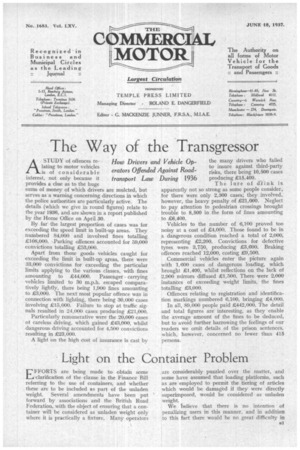The Way of the Transgressor
Page 35

If you've noticed an error in this article please click here to report it so we can fix it.
How Drivers a nd Vehicle Operators Offended Against Roadtransport Law During I 936 ASTUDY of offences reWing to motor vehicles is of considerable interest, not only because it provides a clue as to the huge sums of money of which drivers are mulcted, but serves as a warning concerning directions in which the police authorities are particularly active. The details (which we give in round figures) relate to the year 1936, and are shown in a report published by the Home Office on April 30. By far the largest proportion of cases was for exceeding the speed limit in built-up areas. They numbered 84,000 and involved fines totalling £108,000. Parking offences accounted for 59,000 convictions totalling £53,000.
Apart from those goods vehicles caught for exceeding the limit in built-up areas, there were 33,000 convictions for exceeding the particular limits applying to the various classes, with fines amounting to £44,000. Passenger carrying vehicles limited to 30 m.p.h. escaped comparatively lightly, there being 1,900 fines amounting to £3,000. The next most 'popular offence was in connection with lighting, there being 30,000 cases involving £15,000. Failure to stop at traffic signals resulted in 24,000 cases producing £21,000. Particularly remunerative were the 20,000 cases ot careless driving, which gained £43,000, whilst dangerous driving accounted for 4,500 convictions resulting in £23,000.
A light on the high Cost of insurance is cast by the many drivers who failed to insure against third-party risks, there being 10,500 cases producing £15,400. The lure of drink is apparently not so strong as some people consider, for there were only 2,300 cases; they involved, however, the heavy penalty of £21,000. Neglect to pay attention to pedestrian crossings brought trouble to 8,500 in the form of fines amounting to £6,400.
Vehicles to the number of 6,100 proved too noisy at a cost of £4,000. Those found to be in a dangerous condition reached a total of 2,000, representing £2,200. Convictions for defective tyres. were 3,750, producing £3,600. Braking offences reached 12,000, costing £9,500.
Commercial vehicles enter the picture again with 1,600 cases of dangerous loading, which brought £1,400, whilst reflections on the lack of 2,900 mirrors diffused £1,500. There were 2,000 instances of exceeding weight limits, the fines totalling £3,000.
Offences relating to registration and identificafion markings numbered 6400, bringing £4,000.
In all, 89,000 people paid £442,000. The detail and total figures are interesting, as they enable the average amount of the fines to be deduced, but to avoid further harrowing the feelings of our readers we omit details of the prison sentences, which, however, concerned no fewer than 415 persons.




























































































